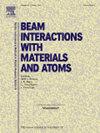利用激光技术减少放射性碳(14C)测量干扰的Li分子去除方法的发展
IF 1.4
3区 物理与天体物理
Q3 INSTRUMENTS & INSTRUMENTATION
Nuclear Instruments & Methods in Physics Research Section B-beam Interactions With Materials and Atoms
Pub Date : 2025-04-22
DOI:10.1016/j.nimb.2025.165714
引用次数: 0
摘要
加速器质谱法(AMS)在高能部分使用偶数个正离子,锂分子离子(Li2)的质量干扰有时会给放射性碳(14C)的精确测量带来挑战。这些分子离子与 14C 具有相同的质量电荷比,它们的存在会导致误差,影响 AMS 测量的可靠性。在这项工作中,我们提出并验证了一种基于激光的选择性去除 Li2 离子的新方法。光纤激光器的光子能量为 1.166 eV,高于 Li2 阴离子电子的结合能,但能量很低,不会影响 14C 阴离子的电子。该方法将 Li2 信号减少了 94.3%,保持了 14C 测量的完整性。我们的研究结果表明,激光技术可以显著提高 AMS 对 14C 分析的灵敏度和可靠性,是各种科学应用的有用工具。本文章由计算机程序翻译,如有差异,请以英文原文为准。
Development of a Li molecular removal method for minimizing interference in radiocarbon (14C) measurements using laser technology
Mass interference of Li molecular ions (Li2) in accelerator mass spectrometry (AMS), which uses an even number of positive ion in the high-energy part, sometimes presents challenges in accurate radioactive carbon (14C) measurements. The presence of these molecular ions, which share the same mass-to-charge ratio as 14C, leads to errors that undermine the reliability of AMS measurements. In this work, we propose and validate a new laser-based method for selectively removing Li2 ions. A fiber-optic laser with 1.166 eV photon energy, which is an energy higher than the binding energy of Li2 anion electrons while at such low energy that it does not affect the electrons of 14C anion, effectively separates only the electrons of Li2 anion. The method reduced the Li2 signal by 94.3 %, maintaining the integrity of the 14C measurement. Our findings indicate that laser technology can significantly improve the AMS sensitivity and reliability for 14C analysis, which can be a useful tool for various scientific applications.
求助全文
通过发布文献求助,成功后即可免费获取论文全文。
去求助
来源期刊
CiteScore
2.80
自引率
7.70%
发文量
231
审稿时长
1.9 months
期刊介绍:
Section B of Nuclear Instruments and Methods in Physics Research covers all aspects of the interaction of energetic beams with atoms, molecules and aggregate forms of matter. This includes ion beam analysis and ion beam modification of materials as well as basic data of importance for these studies. Topics of general interest include: atomic collisions in solids, particle channelling, all aspects of collision cascades, the modification of materials by energetic beams, ion implantation, irradiation - induced changes in materials, the physics and chemistry of beam interactions and the analysis of materials by all forms of energetic radiation. Modification by ion, laser and electron beams for the study of electronic materials, metals, ceramics, insulators, polymers and other important and new materials systems are included. Related studies, such as the application of ion beam analysis to biological, archaeological and geological samples as well as applications to solve problems in planetary science are also welcome. Energetic beams of interest include atomic and molecular ions, neutrons, positrons and muons, plasmas directed at surfaces, electron and photon beams, including laser treated surfaces and studies of solids by photon radiation from rotating anodes, synchrotrons, etc. In addition, the interaction between various forms of radiation and radiation-induced deposition processes are relevant.

 求助内容:
求助内容: 应助结果提醒方式:
应助结果提醒方式:


